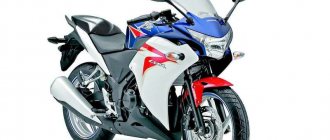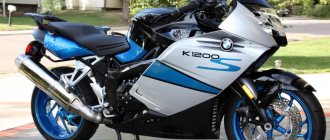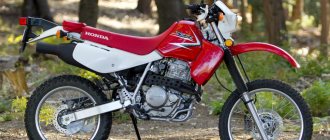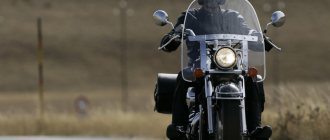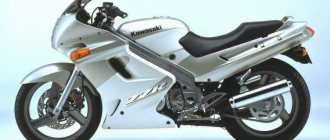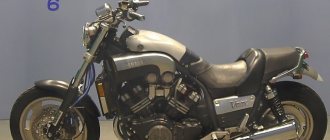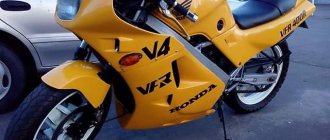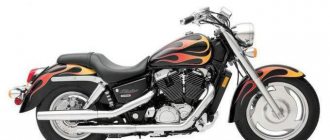| Honda CBR400R (2013-2015) | Honda CBR400R (2016+) |
Model of the budget sports motorcycle Honda CBR400R
was first introduced in 2013 as a domestic modification of the Honda CBR500R. Both models are almost identical to each other and differ only in the engine configuration - the Honda CBR400R engine reduced the crankshaft stroke and increased the compression ratio.
The basis of the Honda CBR400R was an in-line 2-cylinder liquid-cooled engine with a volume of 399 cm³ and producing 46 hp. power and 37 Nm of torque. Maximum engine performance is achieved from 7500 to 9500 rpm.
Other features of the model include a steel frame, simple suspension, single-disc front brake, fuel injection system, 6-speed gearbox, versions with ABS and 192 kg curb weight.
In 2021, the Honda CBR400R model (like the export Honda CBR500R) was restyled, receiving a new appearance, front suspension adjustment and an increase in the fuel tank by 1 liter.
Currently, the Honda CBR400R model is widely represented at Japanese auctions with prices starting from $4,500 including delivery.
The main competitors of the Honda CBR400R in the class:
- Kawasaki Ninja 400
- Yamaha YZF-R3
Brief history of the model
- 2013 - start of production and sales.
Model
: Honda CBR400R + ABS (Japan).
Factory designation
: CBR400RD + CBR400RAD.
- 2014 - no significant changes.
Model
: Honda CBR400R + ABS (Japan).
Factory designation
: CBR400RE + CBR400RAD.
- 2015 - no significant changes.
Model
: Honda CBR400R (Japan).
Factory designation
: CBR400RE.
- 2016 - restyling of the model. Second generation
. The model receives an updated appearance, an enlarged fuel tank (by 1 liter), preload-adjustable front suspension, and adjustable levers.
Model
: Honda CBR400R + ABS (Japan).
Factory designation
: CBR400RG + CBR400RAG.
- 2017 - no significant changes.
Model
: Honda CBR400R + ABS (Japan).
Factory designation
: CBR400RH + CBR400RAH.
- 2018 - Only versions with ABS are offered on the market.
Model
: Honda CBR400R ABS (Japan).
Factory designation
: CBR400RAJ.
- 2019 - no significant changes.
Model
: Honda CBR400R ABS (Japan).
Factory designation
: CBR400RAK.
- 2020 - no significant changes.
Model
: Honda CBR400R ABS (Japan).
Factory designation
: CBR400RAL.
- 2021 - no significant changes.
Model
: Honda CBR400R ABS (Japan).
Factory designation
: CBR400RAM.
Main generations of Honda CBR 400 RR:
1988-1989 - first generation (frame number - NC23).
1990-1999 - second generation (frame number - NC29).
The differences between the first and second generations were a slightly different design of the frame, seat and plastic. There were no technical changes.
The features of the Honda CBR400RR include an aluminum frame, a gear timing drive, a conventional telescopic fork (adjustable for preload) and a monoshock absorber (adjustable for preload and compression), a 6-speed gearbox and 163 kg of dry weight.
Specifications
Technical characteristics of Honda CBR400R:
| Model | Honda CBR400R |
| Motorcycle type | sports |
| Year of issue | 2013+ |
| Frame | steel diagonal |
| engine's type | 2-cylinder, 4-stroke, in-line |
| Working volume | 399 cm³ |
| Bore/Stroke | 67.0 x 56.6 mm |
| Compression ratio | 11,0:1 |
| Cooling | liquid |
| Number of valves per cylinder | DOHC, 4 valves per cylinder |
| Fuel supply system | injector, PGM-Fi |
| Ignition type | fully transistorized |
| Maximum power | 46.0 hp (34.0 kW) at 9500 rpm |
| Maximum torque | 38.0 Nm (3.9 kgm) at 7500 rpm |
| Clutch | Multi-disc in oil bath, cable drive |
| Transmission | 6-speed |
| type of drive | chain |
| Front tire size | 120/70ZR17 M/C (58W) |
| Rear tire size | 160/60ZR17 M/C (69W) |
| Front brakes | 1 disc 320 mm, 2-piston caliper (CBR400RA - ABS) |
| Rear brakes | 1 disc 240 mm, 1 piston caliper (CBR400RA - ABS) |
| Front suspension | 41mm telescopic fork (non-adjustable), 120mm travel – CBR400R (2013-2015) 41mm telescopic fork (preload adjustable), 120mm travel – CBR400R (2016+) |
| Rear suspension | pendulum Pro-Link with monoshock absorber (adjustable preload), stroke - 119 mm |
| Length | 2075 mm – CBR400R (2013-2015) 2080 mm – CBR400R (2016+) |
| Width | 740 mm – CBR400R (2013-2015) 750 mm – CBR400R (2016+) |
| Height | 1145 mm |
| Wheelbase | 1410 mm |
| Minimum ground clearance (clearance) | 140 mm |
| Seat height | 785 mm |
| Acceleration 0-100 km/h (0-60 mph) | 5.98 sec[1] |
| Maximum speed | |
| Gas tank capacity | 15.0 l – CBR400R (2013-2015) 16.0 l – CBR400R (2016+) |
| Motorcycle weight (curb) | 192 kg – CBR400R 194 kg – CBR400R ABS |
Motorcycle history
The bike was originally called the Honda CBR 400 Aero. But since 1988, its appearance was significantly changed, and at the same time its name was changed to Hurricane. In 1994, the motorcycle was modernized and received a new name Fireblade. The device was created in the style of the more expensive Honda CBR 900 RR Fireblade motorcycle (years of production: 1992-1995).
The Honda CBR 400 was equipped with a rather complex 4-cylinder engine with a displacement of 399 cc. The engine characteristics were advanced for that time: max. power 59 l. s., max. torque – 39 Nm. However, during modernization in 1993, due to the need to meet new environmental requirements, the power was reduced to 53 hp. With. The engine showed its main output in the upper speed range from 10,000 to 12,500 rpm.
To distinguish motorcycles of the first generation (1988-1989) from the second (1990-1993), you need to look at the frame number. The first generation had the index NC23 as its number, the second – NC29.
These generations were distinguished solely by their appearance: the shape of the frame, the saddle, and the plastic body kit. From a technical point of view, the device has not changed at all. The third generation of motorcycles (1993-1999) differed from the second by a lower-power power unit.
Among the exceptional features of the Honda CBR400RR motorcycle, the most notable are the aluminum frame, gear-driven timing mechanism, conventional telescopic forks at the front and a monoshock absorber at the rear. Transmission – manual, 6-speed.
Honda CBR 400F3
Maintenance of the Honda SBR 400 motorcycle
Compared to many other 4-cylinder motorcycles, caring for and maintaining the Honda CBR 400RR engine is not a hassle. The power unit has a long service life, but is quite demanding in terms of timely replacement of consumables and oil.
Despite the fact that the power system consists of four carburetors, they are easier to regulate than on similar Yamaha or Suzuki engines. In addition, original Keihin carburetors are renowned for their reliability, trouble-free operation and ease of maintenance.
Honda is distinguished by its motorcycle gearboxes. Thanks to their exceptional reliability and quality, they have become the benchmark in the world of motorcycles. The clutch life is 50 thousand with an aggressive driving style, and much more with a calm driving style.
The suspension and chassis are quite reliable and show good performance even by modern standards. The braking system does not cause any complaints, although many complain about its lack of information. This drawback can be easily corrected by installing reinforced brake hoses.
Honda CBR 400
Post Views: 12,235
Model overview
40 years of evolution and technical progress have given us today a fairly powerful, compact, beautiful and technically well-equipped middle-class motorcycle - the Honda CB 400 Super Four Hyper VTEC 4 versions REVO and BOLDOR. The motorcycle is equipped with a 4-cylinder, 16-valve water-cooled engine with a displacement of 399 cm³.
The car was created for the Japanese domestic market, because there are restrictions for beginner motorcyclists: the engine volume should not exceed 400 cm³, and the power should not exceed 53 hp. The engine is also equipped with an electronic injection system PGM-FI Fuel and a VTEC system.
VTEC works as follows: because the engine is 16-valve (4 valves per cylinder), then from 1st to 5th gear up to 6300 rpm only 2 valves per cylinder are used in the engine operation, the second pair of valves is activated above 6300 rpm and at a fully open throttle to increase power . In 6th gear, all 16 valves are engaged in engine operation.
The appearance of the motorcycle leaves no one indifferent - not only the driver gets pleasure from riding it, but also all passers-by turn around and follow this beautiful car with their eyes.
In terms of design, the motorcycle belongs to the “naked bike” class: it completely lacks plastic panels and fairings, the headlight is round, and the speedometer and tachometer are not covered in any way. The exception is the BOLDOR version: it is equipped with a front fairing and a square headlight .
The riding position on the motorcycle is classic, not sporty, so long-distance trips are not tiring, but for them it is better to have at least a little wind protection, or a BOLDOR version with a fairing: the motorcycle reaches a maximum speed of up to 190 km/h, which is quite a high figure, and At such speeds, drag increases greatly.
The motorcycle is very practical, has a relatively light weight, and is compact in size, making it well suited for dense city traffic and maneuvering between cars in traffic jams.
The motorcycle has a fairly powerful braking system - a large 2-disc brake at the front and a single-disc brake at the rear. The motorcycle has high dynamic characteristics - it accelerates to 100 km/h in 4.5 seconds.
All models of Honda motorcycles in the lineup have impressive characteristics, in each group of motorcycles by type.
Fuel consumption per 100 km in city mode is 4-8 liters, depending on the driver’s driving style.
The figures are so high because the CB400 engine is a modified CBR400RR engine. The modification consisted of increasing torque at low speeds and reducing fuel consumption compared to a sports motorcycle.
The design of the hero of our article is very close to English and resembles Triumph motorcycles. The model range can be found in our article.
The older brother from the Honda lineup was also not deprived of our attention, read here. Review of the motorcycle and its technical characteristics.
Dimensions and weight
The motorcycle has average dimensions for the class: its wheelbase is 1375 mm, its height is 1080 mm, its length is 1990 mm, its width is 670 mm, and its seat height is 750 mm. The weight of the CBR 400 RR is 170 kg, and its tank volume is 15 liters. Fuel consumption greatly depends on driving style. In an aggressive sports race, up to 10 liters can be spent per hundred kilometers, while during quiet movement, about 5 liters can be spent.
Chassis and brakes
The frame of the bike is diagonal and made of aluminum. The latter circumstance makes the motorcycle lighter and much more in line with the sporty direction of the motorcycle than, for example, a steel one. The wheels are alloy and look very elegant, despite their simplicity.
At the rear, a progressive monoshock absorber is used as suspension. At the front, a 41 mm telescopic fork is used. The rear brake features a 220 mm disc along with a two-piston caliper, while the front uses a pair of 275 mm discs along with four-piston calipers.
